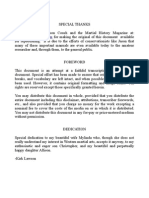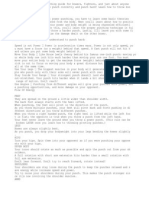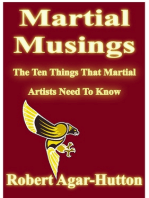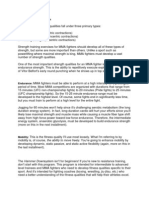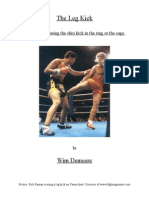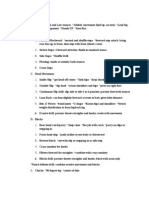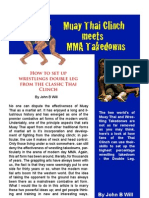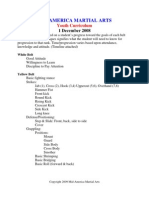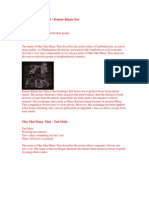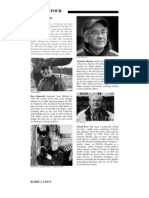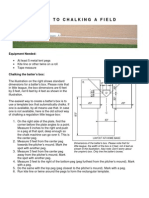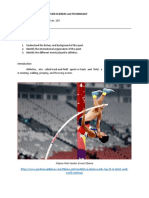Pro Boxing Tips
Pro Boxing Tips
Uploaded by
doggeh12Copyright:
Available Formats
Pro Boxing Tips
Pro Boxing Tips
Uploaded by
doggeh12Original Description:
Copyright
Available Formats
Share this document
Did you find this document useful?
Is this content inappropriate?
Copyright:
Available Formats
Pro Boxing Tips
Pro Boxing Tips
Uploaded by
doggeh12Copyright:
Available Formats
How do pro boxers fight? What techniques do pros use that amateurs don t?
What are some special things that only pros do? What are the things that pros do really well? I ve put together a list of key fighting techniques that I ve seen in practically al l professional boxers but rarely in amateur boxers. Many of these special techni ques are subtle and require truly refined skills that can only be developed thro ugh years of training. They are very hard to see and even harder to do. I share them to the best of my ability for your enjoyment and perhaps future boxing insp iration. Here they are: 10 POPULAR pro boxing techniques!
This guide isn t so much about giving instruction as it is about raising awareness . I will TELL you what they do, but I won t TEACH you what they do (at least not i n this guide). My hope is to at least open your mind to other techniques out the re. It s time for you to start noticing the little details and things that you didn t re alize existed before and hopefully one day incorporate them into your game. If y ou re too inexperienced that you can t notice these details (even with my descriptio ns), you re probably not at the right level to try them yet. It s ok. Give it time a nd one day you ll get there.
1. Staying HEAVY Anybody who s been in the ring with a pro before will know what I m talking about. Y ou know right away when you re in with a pro because he feels as solid as a rock. You can feel his weight even when you re only punching into his guard. You could put 140lb pro in with an amateur 160lb middleweight and the pro will EASILY push th e amateur around. Pros have great balance and stay very grounded. You can feel t heir weight when they punch, when they push you around on the inside, and even w hen you throw a punch into their guard. HOW do the pros stay so heavy? One thing I ve noticed: they re very relaxed that the ir weight can sit comfortably on the ground. They don t move around or fidget around so much like the amateurs. And they hardly take their feet off the ground. It s n ot about being low to the ground, it s about not lifting your legs (and disturbing your center of gravity) so much. Being heavy allows the pros to stand their ground very comfortably. They don t fal l all over the place or fall off balance like amateurs. They stand wherever they want and they move only when they want to move. Their great balance allows them to move faster and move to more angles. Last but not least their superior balan ce allows them to throw punches with so much more power.
2. Endless ANGLES Just like I said, the pros have endless angles. When they re punching you, you fee l like the punches can come from all over. A jab can slice up the middle (passin g the inside of your forearm) or around the side (passing the outside of your fo rearm). A right hand can come high, low, around, under, or straight through. It can come twice. The left hook can come high, low, at your chin, at your forehead
, at the side of your head, at your body. The left hook can hit your body even w hen you think your elbow is blocking it. The uppercuts seem to come from all ove r as well to your head, to your body, even battering you through your gloves. You start to feel like a child hiding behind the door when you helplessly put up a peek-a-boo defense to keep out the pro. He always finds angles to hurt you ev en when you think you re totally covered. You feel like his punches can squeeze th rough the tiniest of holes and hit your chest, your chin, your solar plexus, kid ney, anywhere. When you re the one punching them, the pro always finds an angle to escape. He s ove r, under, to the side, too far back, too close, or always somehow tilted or turn ed away so that your punches have no effect. Most annoying of all is that he s rig ht in front you I mean LITERALLY RIGHT IN FRONT OF YOU.
3. Game-stopping JAB I call the pro boxer s jab a game-stopping jab because it can counter ANY punch. The pros have a jab that can interrupt the opponent NO MATTER WHAT. It can stop his right hand, it can stop his hook. It can stop him from coming forward. Obviousl y, there is one condition: it has to land! How do they do it? Well, it s more than just having that stiff sharp power and gre at accuracy. Pros have such precise timing with their jab. Sometimes they throw it with a fast snap to surprise you. Sometimes they add power to pop you with a counter jab right when you punch. Other times, they throw it as a lightning fast touch to distract you before you can even think of throwing a punch. From any a ngle, any position, the pro s jab always finds a way to interrupt your thoughts an d combinations. It can be long or short, soft or hard, leaning in or leaning back, standing tall or crouched, while moving, while pivoting, well-timed and well-placed. A pro ja b can beat any punch.
4. Make You MISS Wide Pros are so amazing at slipping punches. Their obvious skill is avoiding your pu nch. Their not-so-obvious skill is making you aim at the wrong place. I can thin k of few better ways to evade a punch than by making someone miss in the first p lace. This requires several skills and strategies and LOTS of sparring experience. Pro s are very good at knowing which positions bait which punches. They also know th e natural rhythm and flow of certain combinations. And statistically they re able to guess that from *this* position, the opponent is most likely to throw *this* punch and then follow up with *that* punch. And then what they ll do next is bait *this* position to make you miss the first p unch, and as you re missing, they ll quickly move their head to *that* position to r eally bait you into throwing an even harder follow-up shot. You might have only barely missed the first punch but you ll totally miss the second punch for sure. W hich buys him all the time to land whatever counter-punch or counter-combo he wa nts to throw. What does this require? Skill AND PATIENCE. If the pro had countered after the f irst slip, he would have missed the opportunity to bait you into throwing (and m
issing) an even wider shot. And so pros will slip about 2-3 times to make you mi ss wider and wider before countering you. This is how they create the opportunit ies to land those devastating knockout punches! The pros have been boxing for so long that they always know exactly what punches are likely to come next. Whereas the typical amateur boxer will fire back immed iately because he might not get that opportunity to counter later.
5. Killer INSIDE-FIGHTING Game Pros are especially adept at fighting on the inside for many reasons. They re more comfortable with fighting and exchanging up close (compared to amateur boxers) because the pros have better defensive skills. Amateurs, although quite skillful , still rely more on footwork for defense. The amateur boxing system is based on a point system which helps taller longer guys throw a bunch of pitty-pat shots and run away. Pros have to land damaging shots to win over the judges which requ ires them to get closer and stay in firing range. A pro boxing match can last up to 12 rounds whereas an amateur boxing match is o nly 3 rounds. This means a pro fighter does not have the energy to run as much a nd will need to stay in the inside to conserve energy and or clinch and buy time . Years of being in the ring has allowed pros to become quite comfortable up close with an opponent. They understand punching rhythms and know how to roll off the punches even at point blank. It s also important for pros to know how to fight on the inside because the referee might be biased and let the other guy clinch or use more dirty tactics on the inside. With no energy to run away, they have no c hoice but to get comfortable up close. Pro boxers are really slick on the inside. They know how to wrestle a guy, push him, turn him, spin him, hold him, clinch him. They know how to use their body o n the inside to defend, move, or create space for punches. They can punch and de fend even without looking. I can easily spot pros in a sparring match because they re comfortable being RIGHT IN FRONT of their opponents. And I don t mean this in the way like a reckless bra wler being stupidly aggressive, but a slick guy who is inches in front of his op ponent, slipping and sliding, and totally outmaneuvering even without letting hi s opponent lay a hand on him.
6. Painful BODY SHOTS Body punching is another one of those things that differentiate the pros from th e amateurs. In amateur fighting, head shots are easier to score because they re cl earer and easier to see. There s more of a visual effect when the head snaps back. Body punches aren t as easy to see and score and sometimes look like blocked shot s. With amateur boxing matches being only 3 rounds, there sometimes isn t enough t ime for the fighter to reap the long-term gains of body punching. Body shots can slow down an opponent but they may take some time to really affect the opponent . Another concern for amateurs is losing out on the exchange by getting countered to the head as they go for the body. Quite often, some amateurs only use body pu nches to set up head punches. Many amateurs don t rely on body punching as part of the their main arsenal.
Pro boxers on the other hand are very different! They LOVE body punches and they have the necessary skills to land them. It takes a tremendous amount of skill t o slip inside without taking damage, time the punch to land as the opponent s elbo ws are lifted, aim precisely into the body where it hurts the most, and then get out without getting countered. Imagine having to do all this with a full commit ment of power and not get worried about getting hit in the face while your arm i s down. Pros use body punches for many reasons. Throwing punches to the body can make th eir opponents drop their elbows and expose the head. Body punches can damage the ir opponent s core making it painful to move around (great for slowing down runnin g fighters). Body punches can severely hurt a fighter and take out his wind, rem oving power from his punches. Body punches can be very painful and mentally crip pling to an opponent. A perfectly placed body punch can actually cripple an oppo nent and knock him out. He ll fall to the floor in so much pain and his legs will be so paralyzed that he can t get up (even if he has the heart to continue). Body punches can be a tremendous equalizer in fights where the opponent is too f ast or has too much head movement. Body punches can be used to slow down the fas ter fighters. Body punches can also be used to drag better-skilled opponents int o messy wars where the brawler gets more chances to cause damage. Many boxers wi th great chins have been known to drop their arms freely at times and throw body shots at close range to bait less durable (or less engaging) opponents into dan gerous exchanges.
7. Deceptive DISTANCE Control Pro boxers are so SOOOOOO incredibly clever and deceptive at changing the distan ce on you. I m not talking about the ability to move quickly or have good footwork . I m talking about the ability to move in a way that your opponent cannot feel yo u moving! Imagine a guy whose punches were so perfectly non-telegraphic that you couldn t feel them coming. In the same way, imagine a guy whose footwork was so p erfectly non-telegraphic that you couldn t feel him moving in and out on you. You think he s far away and yet he hits you. Of course he moved in at some point b efore hitting you but you never noticed him moving in. Or sometimes he s up close and right as you re about to throw a punch he s already gone. And again you didn t notic e him moving away! It s even more incredible than that. I ve had pros close 3-4 feet of space and whack me with big combinations without me seeing it! This is something you have to see in person, FROM INSIDE THE RING, to really app reciate. It s easy to watch this on TV and say, Oh he should counter him when he co mes in. But that s the thing YOU CAN T FEEL HIM COMING IN! You cannot feel his body get ting closer, you cannot feel his feet shifting and sliding or whatever he s doing down there. This isn t just good footwork, this is ULTRA-SLICK footwork! Again, it s not about speed, it s about being undetectable. Part of how the pros do it is through using incredibly relaxed footwork. That s the only way. It s like punc hing. As long as you re being totally relaxed and free of tension, the opponent ca nnot read you because you re not loading any tension in your body. There is nothing to read . The other part of it is timing. The pros really understand when are good moments to come in and they have the experience to know when you re not prepared f or it.
8. LEAD right hand
Pros have great lead right hands. It s not the most powerful knockout punch in the world but it s a nice surprisingly quick shot with a just enough pop to stop you in your tracks. They ll land it right as you re about to throw a jab or even right b efore you throw your right hand. A pro popped me good once with a lead right as I came in with my head while trying to throw my right hand. It taught me to keep that head back or maintain a distance always. The lead right is so much faster than you think and so hard to see. The trick to the success of this right hand seems very much to be the result of two things: the body position and the punching technique. Pros use a wider varie ty of relaxed free-flow body positions. They re able to punch and defend from ever y position so they re not always forced to rigidly spring back into the basic stanc e . Because of their skill, they have more freedom to square up their shoulders or lean in at times which brings their right hand closer. Their punching technique for the lead right hand is very much like a jab techniq ue. A quick little pop in the shoulder and that s it, not so much twist in the hip s or pivoting in the feet (like with a normal right hand). They simply hold the ground right there and then *POP!* there goes the lead right. Because their punc hing technique is so minimal, they can get that right hand off so much quicker a nd from any position. The pros lead right hand technique is all about setting up the arm and then firi ng it using a little pop in the shoulder. The real SKILL in landing this punch i s knowing the timing and when to throw it. When thrown properly, you can stun an opponent right in front of you without him even knowing what hit him, it s THAT f ast. And then you can finish him off with some hooks and an even harder right ha nd. Having a fast lead right hand makes your right arm a much more balanced weapon. It s very common that you see a fighter with a well-developed left arm that can th row both fast punches (jabs) and hard punches (hooks/uppercuts) but the right ar m is a bit one-dimensional and can only throw hard long range shots. Having that fast lead right allows the right arm to have both fast and hard punches at your disposal. This makes you far more threatening to your opponents because now the y really have to watch out for both of your hands.
9. WALKING Around This is one of my favorite qualities about pro boxers. They walk around a lot. T hey look so calm, relaxed, and nonchalant about fighting but they re actually alwa ys ready to engage. They ll walk in, hit you, and walk away. Slick as hell, you do n t even realize how easily they walked in on you. And you frustrated when you see how calmly they walk away. When they want to run, they don t jump or panic or any thing like that. They simply walk: a step to the left, another step to the right , maybe two steps to the left again and they re out. Walking keeps their feet grounded, energy conserved, and the fight relaxed. It t akes a really slick fighter to be able to walk around the ring without a care in the world but that is what the pros do well.
10. Lots of TOUCHING Pros touch their opponents a lot. And I mean A LOT. It s a stark contrast to how a mateur boxers fight because amateur boxers are usually keeping their hands up fo
r defense and keeping their hands to themselves. When you watch pros in sparring , you always see them laying their hands on their opponents, touching here and t here. It s such an effective technique and when strategically used, it can create all sorts of offensive and defensive opportunities in the fight. Offensively, you could touch an opponent simply to distract him. Instead of jabb ing him to the head (which is slower), you could touch his head, or if his glove is up, you could touch his glove and then quickly throw a hook to the body. You can punch with the same hand that touched or use the other hand. You could touc h any place to concentrate his guard there and then attack him from a different angle. Defensively, you could touch an opponent to interrupt his punches. Suppose you d idn t have time to throw a counter jab, maybe your body wasn t in position to throw a proper jab or your hand isn t retracted back enough, you could just extend the h and and quickly push his face away. It s a very annoying tactic and can buy you ju st enough time to move away. It s common to see pros touching their opponent s head or shoulders. Touching an opp onent s shoulders can force him to fire a curved punch instead of a straight punch , which is then easily avoided by leaning back. It s easier to defend because you knew what to expect. You can do the same by touching an opponent s head as you mov e away from him. It s annoying and can frustrate an opponent because it limits his punching options and can even prevent him from coming in. On the inside, pros also like to touch an opponent s head or shoulders to use that as a lever to push him or spin him away. Many pros will touch or even hold thei r opponent s shoulders as they move around their opponents. It s pretty slick and ve ry fun to watch. It s important to know that nobody likes to be touched. Even the simple contact of your glove on your opponent s body can make him anxious and exert more energy tha n he would have. I especially like to put my hands on guys with thick arms becau se it makes them more reckless and wears down their heavily-muscled arms. If you v e ever fought a pro before, then you know how annoying it is to have to punch ar ound his forearms all the time.
You might also like
- Kill Team Core RulesDocument29 pagesKill Team Core RulesReiiss Shmuly100% (2)
- Official Walkthrough - Season 3 - PatreonDocument188 pagesOfficial Walkthrough - Season 3 - Patreonwisnu kusuma100% (1)
- Mayweather WorkoutDocument2 pagesMayweather WorkoutLacHun1850% (2)
- Mittmaster 1Document136 pagesMittmaster 1Isagani Abon0% (1)
- ExpertBoxing Free Boxing Course PDFDocument13 pagesExpertBoxing Free Boxing Course PDFmemememeNo ratings yet
- MittmasterKickboxingSyllabusV1 1541029557497Document13 pagesMittmasterKickboxingSyllabusV1 1541029557497Matthew BeachouseChillin BayodeNo ratings yet
- Boxing Skills TrainingDocument12 pagesBoxing Skills Trainingscotty789100% (1)
- Planilha Resultado 2019 Ensino Medio Am InstitutofederaldeeducaocinciaetecnologiadoamazonascampusmanauszonalesteDocument1,152 pagesPlanilha Resultado 2019 Ensino Medio Am InstitutofederaldeeducaocinciaetecnologiadoamazonascampusmanauszonalesteJanderson BritoNo ratings yet
- World Cup AnalysisDocument15 pagesWorld Cup AnalysisHelena Nadine Mendes FerreiraNo ratings yet
- Bescherelle École - Mon Maxi Cahier D'anglais CP, CE1, CE2, CM1, CM2 (Bescherelle Langues) (French Edition)Document1 pageBescherelle École - Mon Maxi Cahier D'anglais CP, CE1, CE2, CM1, CM2 (Bescherelle Langues) (French Edition)Anna Maciejewska0% (4)
- Boxing Mastery: Advanced Technique, Tactics, and Strategies from the Sweet ScienceFrom EverandBoxing Mastery: Advanced Technique, Tactics, and Strategies from the Sweet ScienceRating: 4.5 out of 5 stars4.5/5 (7)
- Homemade Grappling DummyDocument16 pagesHomemade Grappling DummyCross9992No ratings yet
- American Jiu Jitsu - LaniusDocument57 pagesAmerican Jiu Jitsu - LaniusmystrjoeNo ratings yet
- Send This To Training Partners and Friends!: Never GasDocument45 pagesSend This To Training Partners and Friends!: Never GascavaleramaxNo ratings yet
- Martial Arts - Bruce Lee's Speed Training - Ebook PDFDocument4 pagesMartial Arts - Bruce Lee's Speed Training - Ebook PDFGeorge George George0% (1)
- Youth Boxing TrainingDocument3 pagesYouth Boxing TrainingDrum_GRNo ratings yet
- Understanding The Design of Crazy Monkey DefenseDocument12 pagesUnderstanding The Design of Crazy Monkey DefenseRodney King100% (2)
- Billiards InstructionDocument15 pagesBilliards Instructionverdanto100% (1)
- Boxing FundamentalsDocument48 pagesBoxing FundamentalsglenNo ratings yet
- Punching TechniqueDocument4 pagesPunching Techniquedoggeh12100% (1)
- Top 10 Fighting StylesDocument12 pagesTop 10 Fighting StylesAnimesh Ghosh100% (1)
- Martial Arts: How Do I Punch Harder?: Anatomy of A Hard PunchDocument9 pagesMartial Arts: How Do I Punch Harder?: Anatomy of A Hard Punchcepol100% (2)
- 10 Mistakes Boxing v1 PDFDocument16 pages10 Mistakes Boxing v1 PDFDavyJones555100% (1)
- Boxing. The Martial Art of BoxingDocument3 pagesBoxing. The Martial Art of BoxingDROMEAS100% (1)
- How To Box: The BasicsDocument13 pagesHow To Box: The BasicsBoxTrainFit100% (1)
- Martial Musings: The Ten Things That Martial Artists Need To KnowFrom EverandMartial Musings: The Ten Things That Martial Artists Need To KnowRating: 5 out of 5 stars5/5 (1)
- Boxing's Ten Commandments: Essential Training for the Sweet ScienceFrom EverandBoxing's Ten Commandments: Essential Training for the Sweet ScienceRating: 4.5 out of 5 stars4.5/5 (5)
- More No Holds Barred Fighting: Killer SubmissionsFrom EverandMore No Holds Barred Fighting: Killer SubmissionsRating: 3 out of 5 stars3/5 (1)
- Kickboxing: Short Range Fighting: From Initiation To Knockout: Kickboxing: From Initiation To Knockout, #6From EverandKickboxing: Short Range Fighting: From Initiation To Knockout: Kickboxing: From Initiation To Knockout, #6No ratings yet
- Boxer's Bible of Counterpunching: The Killer Response to Any AttackFrom EverandBoxer's Bible of Counterpunching: The Killer Response to Any AttackRating: 5 out of 5 stars5/5 (5)
- Grind or Grace: Fighters, Mentors, Entrepreneurs. 10 Jiu-Jitsu Principles for Stress-Free SuccessFrom EverandGrind or Grace: Fighters, Mentors, Entrepreneurs. 10 Jiu-Jitsu Principles for Stress-Free SuccessNo ratings yet
- Kickboxing: The Jab: From Initiation To Knockout: Kickboxing: From Initiation To Knockout, #1From EverandKickboxing: The Jab: From Initiation To Knockout: Kickboxing: From Initiation To Knockout, #1No ratings yet
- Highlander Boxing ProgramDocument3 pagesHighlander Boxing Programgtlaau50% (2)
- BoxingDocument4 pagesBoxinghrythmlbsim100% (1)
- Boxing - The Ultimate Guide To Beginning Boxing Martial Arts - MMA Mixed Martial Arts Grappling Brazilian Jiu JitsuDocument41 pagesBoxing - The Ultimate Guide To Beginning Boxing Martial Arts - MMA Mixed Martial Arts Grappling Brazilian Jiu JitsuscribdedNo ratings yet
- 6 Day Advanced Boxing Training RoutineDocument10 pages6 Day Advanced Boxing Training RoutineTadgh McEneaneyNo ratings yet
- Hammer Down Training Program For Mixed Martial ArtDocument40 pagesHammer Down Training Program For Mixed Martial ArtOng-Art PollockNo ratings yet
- Monday (Punching Combinations, Power + Core Exercises) : Exercise 1 - Long Distance Combinations: First SetDocument7 pagesMonday (Punching Combinations, Power + Core Exercises) : Exercise 1 - Long Distance Combinations: First SetJulio OlmedoNo ratings yet
- Boxing Basics GuideDocument9 pagesBoxing Basics GuideFarha Rahman100% (1)
- Boxing: "You Only Live Once, But If You Work It Right, Once Is Enough." - Joe LewisDocument21 pagesBoxing: "You Only Live Once, But If You Work It Right, Once Is Enough." - Joe LewisTimothy100% (2)
- The Leg Kick - A Guide For Devastating Low Kicks in MMA and Muay ThaiDocument25 pagesThe Leg Kick - A Guide For Devastating Low Kicks in MMA and Muay Thaifahren-heit tepes100% (3)
- Heavy Bag Drills e BookDocument11 pagesHeavy Bag Drills e BookBeka Berikashvili100% (1)
- Brute ScheduleDocument6 pagesBrute ScheduleReshma SakpalNo ratings yet
- MMA Striking ClassDocument6 pagesMMA Striking ClassJohn Keay100% (1)
- Cage Match - Popular Science Greg Jackson Using Game Theory PDFDocument12 pagesCage Match - Popular Science Greg Jackson Using Game Theory PDFYasser E KasanNo ratings yet
- Progressive Calisthenics For StrengthDocument9 pagesProgressive Calisthenics For StrengthHarry Chriz100% (1)
- Tre Loar ScienceDocument62 pagesTre Loar SciencejacsavageNo ratings yet
- Muay Thai Clinch Meets MMA TakedownsDocument5 pagesMuay Thai Clinch Meets MMA TakedownsblaatenatorNo ratings yet
- 101 Ways To Improve Your Skills in MMADocument6 pages101 Ways To Improve Your Skills in MMAMarco PagariganNo ratings yet
- 7 Secrets of Bareknuckle PrizefightersDocument10 pages7 Secrets of Bareknuckle PrizefightersVitor Oliveira100% (3)
- 3 Drills For Improving Your Neck StrengthDocument10 pages3 Drills For Improving Your Neck StrengthbajetownrepNo ratings yet
- How To Wrestle - Instructions of Frank GotchDocument66 pagesHow To Wrestle - Instructions of Frank GotchDecameron100% (2)
- Exercises To Develop Neck StrengthDocument14 pagesExercises To Develop Neck StrengthbluhartNo ratings yet
- Guide To Shadow BoxingDocument5 pagesGuide To Shadow BoxingAmitNo ratings yet
- 30 Exercises For Youth WrestlersDocument31 pages30 Exercises For Youth WrestlersJose Fortuna100% (3)
- Mid-America Martial Arts: Youth CurriculumDocument8 pagesMid-America Martial Arts: Youth CurriculumSelf DefenceNo ratings yet
- Mae Mai Muay ThaiDocument20 pagesMae Mai Muay ThaiJovi Henry50% (4)
- The Sweet Science 101Document35 pagesThe Sweet Science 101Pippo KennedyNo ratings yet
- Punching With Power1Document89 pagesPunching With Power1BLEE GAMINGNo ratings yet
- American Folkstyle Wrestling: US PresidentsDocument2 pagesAmerican Folkstyle Wrestling: US PresidentsRobert Allen Rippey100% (1)
- Common Punching Combinations: PunchesDocument2 pagesCommon Punching Combinations: PunchesJohnYvnNo ratings yet
- Fifa 2006Document8 pagesFifa 2006mrgbatraNo ratings yet
- Raise A Colt 07 Chapter FourDocument13 pagesRaise A Colt 07 Chapter FourmaritimeclassicsNo ratings yet
- 2023 Trends HandoutDocument2 pages2023 Trends HandoutJuliana DuarteNo ratings yet
- Daniel Tong Resume 2021Document1 pageDaniel Tong Resume 2021api-336510768No ratings yet
- MC 2022-2309Document2 pagesMC 2022-2309Ernest Mendoza100% (1)
- Physical Education & Sports MCQ: (C) 5 X 3 MtsDocument7 pagesPhysical Education & Sports MCQ: (C) 5 X 3 MtsKhan LaLaNo ratings yet
- Aryan Classes - NTSE - STSE - Tamil Nadu - ResultDocument26 pagesAryan Classes - NTSE - STSE - Tamil Nadu - ResultSuresh KanniappanNo ratings yet
- FINAL MODULE PE 1 - Pages 13 To 20Document21 pagesFINAL MODULE PE 1 - Pages 13 To 20maxene jade100% (1)
- 卖火柴的小女孩英文剧本Document4 pages卖火柴的小女孩英文剧本nhpaciteNo ratings yet
- Guide To Chalking A Baseball FieldDocument2 pagesGuide To Chalking A Baseball Fieldwgillis1No ratings yet
- Os Complete Final AnswerDocument198 pagesOs Complete Final AnswerDeshini Balasubramaniam100% (4)
- Fontes Powerbox (Screen Serviçe)Document7 pagesFontes Powerbox (Screen Serviçe)EDSON ROCHANo ratings yet
- A282 Chapter 2 - Coulomb Forces and Electric Field IntensityDocument26 pagesA282 Chapter 2 - Coulomb Forces and Electric Field IntensitySisyloen OirasorNo ratings yet
- Summary Throne of FireDocument4 pagesSummary Throne of Firediane.studybsaNo ratings yet
- NC 2015 SEPT Physics P 1Document18 pagesNC 2015 SEPT Physics P 1motaungmotjhesane60No ratings yet
- January Silver AnswersDocument31 pagesJanuary Silver AnswersNagajyothi KodaliNo ratings yet
- Module4 AthleticsDocument13 pagesModule4 AthleticsMatthew ScarellaNo ratings yet
- Lighthouse August 9, 2012Document48 pagesLighthouse August 9, 2012VCStarNo ratings yet
- Add Inches Where It Really Matters ) Grow Your Arms WithDocument12 pagesAdd Inches Where It Really Matters ) Grow Your Arms WithGiuliano Di FranciscoNo ratings yet
- Nylon Whip Tutorial Part 1Document5 pagesNylon Whip Tutorial Part 1Кристоф МртнзNo ratings yet
- GGE Jason and The ArgonautsDocument24 pagesGGE Jason and The Argonautsmileslegionis100% (1)
- Interval BookletDocument103 pagesInterval BookletmetronommeNo ratings yet
- DAC 056 056S Spare ListDocument1 pageDAC 056 056S Spare ListoespinozapNo ratings yet
- 4871 - 399 Electromechanical Steering With Parallel Assist VWDocument40 pages4871 - 399 Electromechanical Steering With Parallel Assist VWVibhav Sridharan100% (2)












